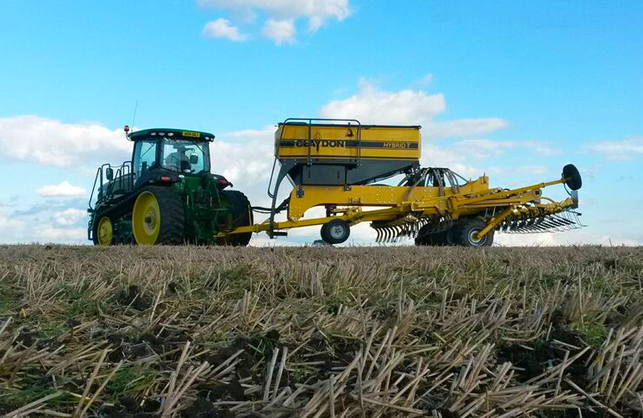
Claydon Drills produce time and cost-saving agricultural tools, such as this Hybrid-T model, for cultivating and planting the land
Farming equipment company Claydon Drills began its life on the farm, and still brings generations of experience to its products from the rural fields of Suffolk.
Founded in 1980 by Jeff Claydon, his first creation, the Yield-O-Meter, was a revolutionary load counter for combine harvesters.
Essentially a calculator in the driver’s cabin, it could calculate how much crop the machine had collected over a certain area.
Arriving at a period where digital technology was beginning to find its way into farming, it also allowed farmers to experiment too.
Trial plots – using different fertilisers, seeds, planting methods – to get the best results and being able to measure these yields, allowed farming to take the first steps into becoming the modern, technology-driven industry it is today.

The designs evolved through the Claydon family’s own needs for more economic farming
Claydon Drills is still farming the family’s thousand acres of arable land, however a loss of profits in 2002 saw Jeff Claydon inventing once more.
Over a decade later, and with a cluster of storage barns and assembly workshops humming with action, this path to rescue has been a success with customers as far away as New Zealand and Chile.
Jeff’s son Oliver, now design director at Claydon Drills, explains that the path to innovation came through that loss-making patch in 2002.
“We can’t change the input costs of farming because diesel is a fixed price, fertiliser is a fixed price, we’re told what we will buy everything for, and can’t change what we sell for because it’s demand on the global market. All we can really do is play with what we’ve got in the middle, which is really how we farm,” he explains.
Aiming high
Jeff Claydon’s aim was to improve the process of ‘direct drilling’ arable land, which struggles to work in the UK because of heavy clay-based soils that fill up with water, rotting the seed.
Natural factors like earthworms not thriving in the same soil to de-compact it also mean that slugs then thrive, tearing through harvests.

Folding ‘wings’ mean customers can have bigger machines that fit on the road legally
Claydon Drills decided that by tilling the soil over only in the area that needed to be planted – a labour intensive process needed to air the soil – and ignoring the rest of the field, it could halve this cost.
The idea came to put a digging tine directly in front of a seeding tine, with a harrow on the back. The digging tine provides cultivation and breaks the soil, and in the same pass the seeding tine places the seed in the right place with the harrow covering it back over with soil.
A huge success, the general principle of how the product works has not changed since 2002 – yet its evolution has not stopped.
The expanded product line is a continuing progression of tweaks and design improvements built on the Claydon Drills team’s own experiences, and from its users around the world that run the equipment 12 hours a day for nearly two months during the season.
The demand for bigger machines meant the need to incorporate a folding-mechanism, allowing the ‘wings’ to pull upright so as to fit on public roads, and pushed through the need for in-house 3D CAD and a shift from building solution and outsourcing 2D drawings afterwards.
“The design process at the beginning was to get some off-the-shelf parts, go into the workshop with an oxyacetylene torch, a mig welder and some hand tools – it was very much A-Team stuff!” says Oliver Claydon.
Jump to 3D
In 2006 the company made the jump to 3D, taking SolidWorks in-house with help from Innova Systems, freeing its designs from the limitations of stock parts increasing the amount of its own design work.
By 2009 it had designed the Hybrid model – a combination of the best parts of its previous drills – dropping the weight and adding some deceptively well thought out design components.

The team use SolidWorks to model increasingly complex design systems for weight distribution, strength and efficiency
A better-designed hopper to hold the seed means the wings can fold upright, doubling the wingspan from three metres to six.
The latest design has cut operation time on the Claydons’ own farm by a fifth, and costs them only a third of their original design – a saving of nearly £100,000 a year.
At an estimate, Claydon suggests that 80 to 90 per cent of its operation now is first modelled in 3D and through taking in STEP files from component suppliers.
With a workload of producing over 300 machines annually for this small enterprise, it means things like rendering models in Photoview 360 are a luxury.
Yet a tool such as the SolidWorks assembly structure planning tool, Treehouse, proves invaluable for getting machinery built, ready for the new season.
In the future the company will utilise more of the software features, adding more virtual engineering to the team’s hands-on approach, and increasing the range of products that has already expanded to form a flourishing business.

Farming equipment company Claydon Drills enters the 3D CAD world
Default






